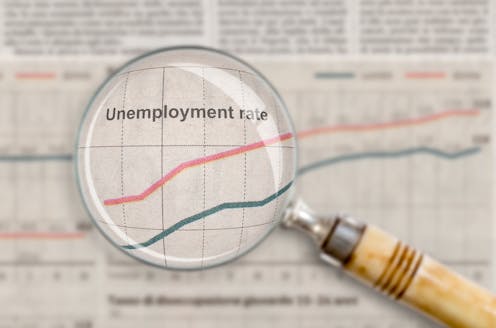Economic ‘green shoots’ and lower interest rates disguise worrying trends in NZ’s job market
- Written by Cristóbal Castro Barrientos, PhD candidate, NZ Policy Research Institute, Auckland University of Technology

Despite Prime Minister Christopher Luxon’s reassurance that “some green shoots” are starting to show in the economy[1], including a 50 point cut in the official cash rate[2] expected to be announced later today, the outlook for 2025 remains uncertain for many – and grim for some.
Unemployment reached 5.1% in the final quarter of 2024[3], the highest level since 2020, according to the latest data from Stats NZ. That translates to a total of 156,000 unemployed individuals.
At the same time, a 1% decrease in gross domestic product in the third quarter of 2024 puts more pressure on the job market.
While the unemployment rate may not have reached the levels of past crises – the rate exceeded 6% during the 2008-2009 recession – the devil is in the detail.
The Stats NZ data show the most affected sectors include male-dominated occupations such as technicians and machinery operators, accounting for 85% of the latest job losses.
Women have seen smaller declines in employment and a slight increase in transitions to part-time roles. But the shift from full-time to part-time employment, especially among men, suggests the creation of quality full-time jobs will be a challenge.
Job losses concentrated in male-dominated industries also have broader economic implications. They may signal shifts in household income dynamics, particularly for families that depend on a male breadwinner.
It could also contribute to rising male underemployment (when a worker’s job doesn’t fully utilise their skills, education or experience) and further disparities in the employment rates of men and women.
Overall, these trends raise questions about the nature and quality of work now available in the job market, and what strategies the government can respond with.
A rise in ‘discouraged’ workers
In the fourth quarter of 2024, the annualised employment rate (representing the proportion of the working-age population employed over a year, adjusted for seasonal fluctuations) was 67.4%, compared with 69% in the same period of the previous year.
This is the most significant decline since 2009. It reflects job losses and a “discouraged worker” effect.
Discouraged workers are those who have stopped seeking employment due to a perceived lack of opportunities. Instead of remaining in the labour force, they may rely on savings, family support, welfare, or transition into informal or temporary work.
A drop in quality work
The rise in part-time employment, particularly among men, raises concerns about the quality of the labour market. Although employment levels appear stable, the growth of less secure jobs may conceal structural weaknesses.
In the fourth quarter of 2024, the number in part-time employment reached 585,000, the highest figure since 1986. Over the past year, 36,000 men left full-time jobs, while 9,000 transitioned to part-time work.
One of the main risks of this trend is that companies may be cutting costs without resorting to mass layoffs[5], which implies reduced job security for workers. Many of these transitions to part-time employment are not voluntary but rather a sign that the economy is not generating enough stable job opportunities.
Additionally, part-time jobs often offer lower wages, fewer benefits and fewer opportunities for career advancement.
This type of employment can contribute to stagnation in skill development and reduce workers’ purchasing power, ultimately affecting consumer spending and overall economic growth.
There is also a perception of discrimination against part-time workers, with one in three reporting feeling discriminated against[6] in their jobs.
A year of two halves
While consumer confidence has been low, recent revisions to economic growth estimates suggest the economy hasn’t been as weak as perceived[7].
Current projections are that unemployment may reach a peak between 5.3% and 5.6% in mid-2025 and then trend downwards.
With inflation now within the Reserve Bank of New Zealand’s target range[8], changes in the official cash rate are needed to contain the damage to a weakened labour market. The central bank is forecast to cut the interest rate by 50-points today.
The weak growth in the working-age population and a potential decline in labour force participation could limit how high unemployment rises, as fewer people may be actively looking for work. But this does not mean a strong recovery is imminent.
New Zealand faces a significant but not insurmountable challenge. An unemployment rate of 5.1% should raise a red flag and is devastating for the increasing number of workers who have lost their jobs. But the data also show the increase is part of an anticipated economic cycle.
What matters is how the government reacts to the increases in unemployment and changes to the job market. A supportive job-creation policy and a coordinated strategy for the most affected sectors will be key in avoiding long-lasting pain in the labour market.
References
- ^ “some green shoots” are starting to show in the economy (www.parliament.nz)
- ^ 50 point cut in the official cash rate (www.interest.co.nz)
- ^ final quarter of 2024 (www.nzherald.co.nz)
- ^ Kajohnwit Boonsom/Shutterstock (www.shutterstock.com)
- ^ cutting costs without resorting to mass layoffs (www.rnz.co.nz)
- ^ one in three reporting feeling discriminated against (talent.seek.co.nz)
- ^ economy hasn’t been as weak as perceived (rnz.co.nz)
- ^ Reserve Bank of New Zealand’s target range (www.1news.co.nz)
Authors: Cristóbal Castro Barrientos, PhD candidate, NZ Policy Research Institute, Auckland University of Technology







